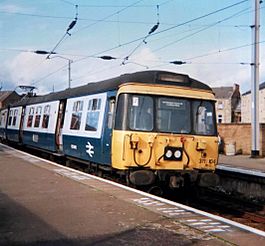British Rail Class 311 facts for kids
Quick facts for kids British Rail Class 311 |
|
|---|---|

Unit 311104 in blue/grey livery awaiting passengers at Partick.
|
|
| In service | 1967 - 1999 |
| Manufacturer | Cravens |
| Number built | 19 |
| Formation | 3 cars per trainset |
| Capacity | 236 seats |
| Operator(s) | British Rail |
| Specifications | |
| Maximum speed | 75mph (121km/h) |
| Weight | Total - 129 tons |
| Braking system(s) | Air (Auto/EP) |
| Track gauge | 1,435 mm (4 ft 8 1⁄2 in) |
The British Rail Class 311 was a type of electric train used in the United Kingdom. These trains were built in 1967 by a company called Cravens in Sheffield. They were designed to run on special electric railway lines.
Contents
What is the Class 311 Train?
The Class 311 trains were known as electric multiple units (EMUs). This means they were electric trains made up of several connected carriages that could run together as one unit. They used alternating current (AC) electricity to power their motors.
Where Did These Trains Run?
These trains were made specifically for lines in Scotland. They were used on routes connecting Glasgow Central to places like Gourock and Wemyss Bay. These particular train lines were made electric in 1967, which was the same year the Class 311 trains were built.
How Were They Designed?
The Class 311 trains were built with a specific purpose in mind. Each train was made up of three separate cars or carriages. This design allowed them to carry many passengers.
Key Features of the Class 311
Each Class 311 train weighed about 129 tons in total. They could carry up to 236 seated passengers, making them good for busy routes. These trains could reach a top speed of 75 miles per hour (121 kilometers per hour). They used air brakes to slow down and stop safely.
When Did They Operate?
The Class 311 trains started carrying passengers in 1967, the year they were built. They were an important part of the British Rail fleet for many years. These trains continued to serve passengers until 1999, when they were eventually retired from service.

